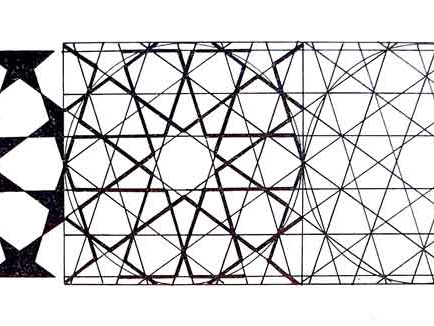The world's first puzzle craze occurred almost 200 years ago, during the years 1817 and 1818, when transportation and communication consisted of sailing ships and horse-drawn carts and carriages.A Chinese Puzzle, later named the Tangram swept from China to London and became a fashionable puzzle craze in England , Europe and America. This remarkable event was the world's first puzzle craze.
The Tangram is still popular and has been used in schools worldwide to help students learn, while having fun, since the 1860s.
The Tangram is still popular and has been used in schools worldwide to help students learn, while having fun, since the 1860s.
The Tangram, a two-dimensional rearrangement puzzle, is formed by dissecting (cutting) a square into seven pieces, called tans.
The pieces are rearranged to form thousands of different figures of people in motion, animals, letters of the alphabet, geometric shapes and the universe.
The puzzle is to assemble all seven pieces, without overlap, to form a given problem figure.
Several rearrangement puzzles were invented before the Tangram and many have been invented since, but the Tangram has turned out to be the most popular by far. The seven pieces are simple shapes: two small triangles, one medium-sized triangle, two large triangles, a rhomboid and a square.
The pieces are rearranged to form thousands of different figures of people in motion, animals, letters of the alphabet, geometric shapes and the universe.
The puzzle is to assemble all seven pieces, without overlap, to form a given problem figure.
Several rearrangement puzzles were invented before the Tangram and many have been invented since, but the Tangram has turned out to be the most popular by far. The seven pieces are simple shapes: two small triangles, one medium-sized triangle, two large triangles, a rhomboid and a square.
According to Chinese reference literature,Yang-chochii-shih (Dimwitted recluse) invented theTangram during the reign of Chia-ch'ing (r796-I820). He wrote,edited and published the first Tangram problem manuscript ( or book). The inventor and author used a pen name, as was common in China during this period. No copies of the book are known to exist.
The date of the first Tangram may be further defined by the hand-written inscription on a silk covered cardboard box containing a carved ivory Tangram that was given to Francis Waln, the third child of Robert and Phebe Waln, on April 4, 1802.
Robert Waln was a major ship owner and importer in Philadelphia with a financial interest in
at least twelve ships trading with Canton, China.
The date of the first Tangram may be further defined by the hand-written inscription on a silk covered cardboard box containing a carved ivory Tangram that was given to Francis Waln, the third child of Robert and Phebe Waln, on April 4, 1802.
Robert Waln was a major ship owner and importer in Philadelphia with a financial interest in
at least twelve ships trading with Canton, China.
- From the article, ‘Tangram, the world’s first puzzle craze’ by Jerry Slocum
The ancient Chinese story of the tangram is that a sage, a wise old man was to take a precious sheet of glass to the king who needed a window in his palace.
The square piece of glass was wrapped in silk and canvas and carried in the sage's backpack.
The journey was long, the sage crossed a desert and rivers, he travelled through forests and fields. He arrived at a rugged mountain range and climbed to the summit of a high, rocky peak. At the top of the mountain he looked into the distance and glimpsed the palace he was travelling to.
Pleased that he had almost arrived, he stumbled and tumbled down the side of the mountain. The glass was broken.
Pleased that he had almost arrived, he stumbled and tumbled down the side of the mountain. The glass was broken.
When he met the king he told of his journey and admitted that the glass was broken. The square glass was unwrapped from its silk and canvas case and the sage was surprised to see that glass was not shattered but divided into seven geometric shapes.
The sage moved the shapes around and made images to describe his journey.
He showed the king his home, a camel he had seen in the desert, monks he met on his way, a boat on the river he crossed and the mountain range where he fell.
The king enjoyed the geometric images and had the shapes recreated in wood. . . Tangrams were invented.
He showed the king his home, a camel he had seen in the desert, monks he met on his way, a boat on the river he crossed and the mountain range where he fell.
The king enjoyed the geometric images and had the shapes recreated in wood. . . Tangrams were invented.
- From https://www.tangram-channel.com/legend-of-the-tangram/




